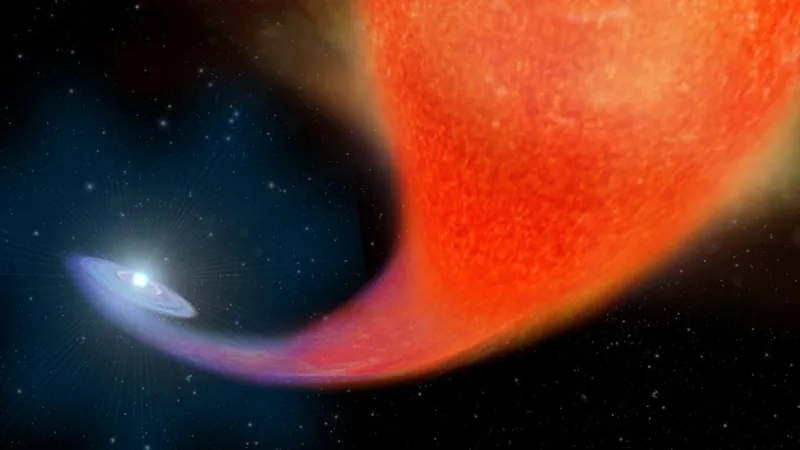
Hubble Telescope Unveils Mystifying 'Blue Lurker' Star in Stellar Love Triangle!
2025-01-22
Author: Yan
Groundbreaking Discovery by Hubble Space Telescope
In a groundbreaking discovery, the Hubble Space Telescope has spotted an extraordinary "blue lurker" star engaged in a cosmic feast with its two conjoined star siblings. This finding provides an unprecedented glimpse into the intricate dynamics of multiple-star systems.
Significance of the Discovery
According to astronomer Eric Sandquist from San Diego State University, who wasn’t involved in the research, “It's a good mid-evolution snapshot of this system, and maybe it will help us put together a clearer picture of the overall evolution of triple systems." This new observation is significant as it not only showcases a unique stellar relationship but also enhances our understanding of how stars evolve together over billions of years.
Characteristics of the Blue Lurker
While this blue lurker may bear a resemblance to our sun, it spins at an astonishing rate—much faster than its counterparts—due to the collective gravitational forces of the three stars in this system. The "blue" label indicates the star's extreme heat, which gives it a blue appearance, setting it apart from the cooler and slower stars in its vicinity.
The M67 Star Cluster
The blue lurker is part of the M67 star cluster, also known as the "King Cobra Cluster." This ancient cluster is around 4 billion years old and contains roughly 500 stars located 2,800 light-years away from Earth. The stars in M67 share a common age, leading to similar rotational speeds—but exceptions like the blue lurker provide an exciting avenue for research.
Rotational Speeds
A typical star in the M67 cluster rotates roughly once every 25 days, akin to our sun. In contrast, the blue lurker puts on an impressive show by whirling around every few days. Emily Leiner, an astronomer at the Illinois Institute of Technology, mentioned during a recent presentation, “The blue lurkers were whipping around every few days.”
Research Findings
Leiner and her team made it their mission to investigate this exceptionally fast star, turning the Hubble telescope’s gaze towards it. Their research revealed that the blue lurker is accompanied by a white dwarf, which is the remnant of a star that has exhausted its nuclear fuel. Intriguingly, this white dwarf is so massive that research indicates it is likely the result of a star merger, hinting at a complex origin story.
Cosmic Evolution Narrative
The relationship is a cosmic tale of evolution and transformation: the blue lurker originally orbited two binary stars engaged in a gravitational dance. Eventually, these binary stars fused to form a massive star, which then swelled as it aged. The blue lurker began siphoning material from this swollen star, resulting in its rapid rotation as the white dwarf, now in its death throes, added to the drama.
Challenges in Stellar Research
Leiner states, "It's not rare for stars to go through this mass-transfer process; what's harder is finding them." Approximately 10% of stars exist in triple systems like this one, but tracking their evolutionary narratives is a complex task. The life cycles of single stars are relatively straightforward to model, whereas the intricacies of multi-star systems require detailed observations to unravel their histories.
Implications for Astronomy
This remarkable discovery not only sheds light on the dynamics of star systems but also poses further questions about the birth and death of stars in the universe. As telescopes like Hubble continue to observe and reveal the secrets of the cosmos, we find ourselves deeper in awe of the intricate dance of celestial bodies. What other mysteries dwell in the stars above? Stay tuned!





 Brasil (PT)
Brasil (PT)
 Canada (EN)
Canada (EN)
 Chile (ES)
Chile (ES)
 Česko (CS)
Česko (CS)
 대한민국 (KO)
대한민국 (KO)
 España (ES)
España (ES)
 France (FR)
France (FR)
 Hong Kong (EN)
Hong Kong (EN)
 Italia (IT)
Italia (IT)
 日本 (JA)
日本 (JA)
 Magyarország (HU)
Magyarország (HU)
 Norge (NO)
Norge (NO)
 Polska (PL)
Polska (PL)
 Schweiz (DE)
Schweiz (DE)
 Singapore (EN)
Singapore (EN)
 Sverige (SV)
Sverige (SV)
 Suomi (FI)
Suomi (FI)
 Türkiye (TR)
Türkiye (TR)
 الإمارات العربية المتحدة (AR)
الإمارات العربية المتحدة (AR)